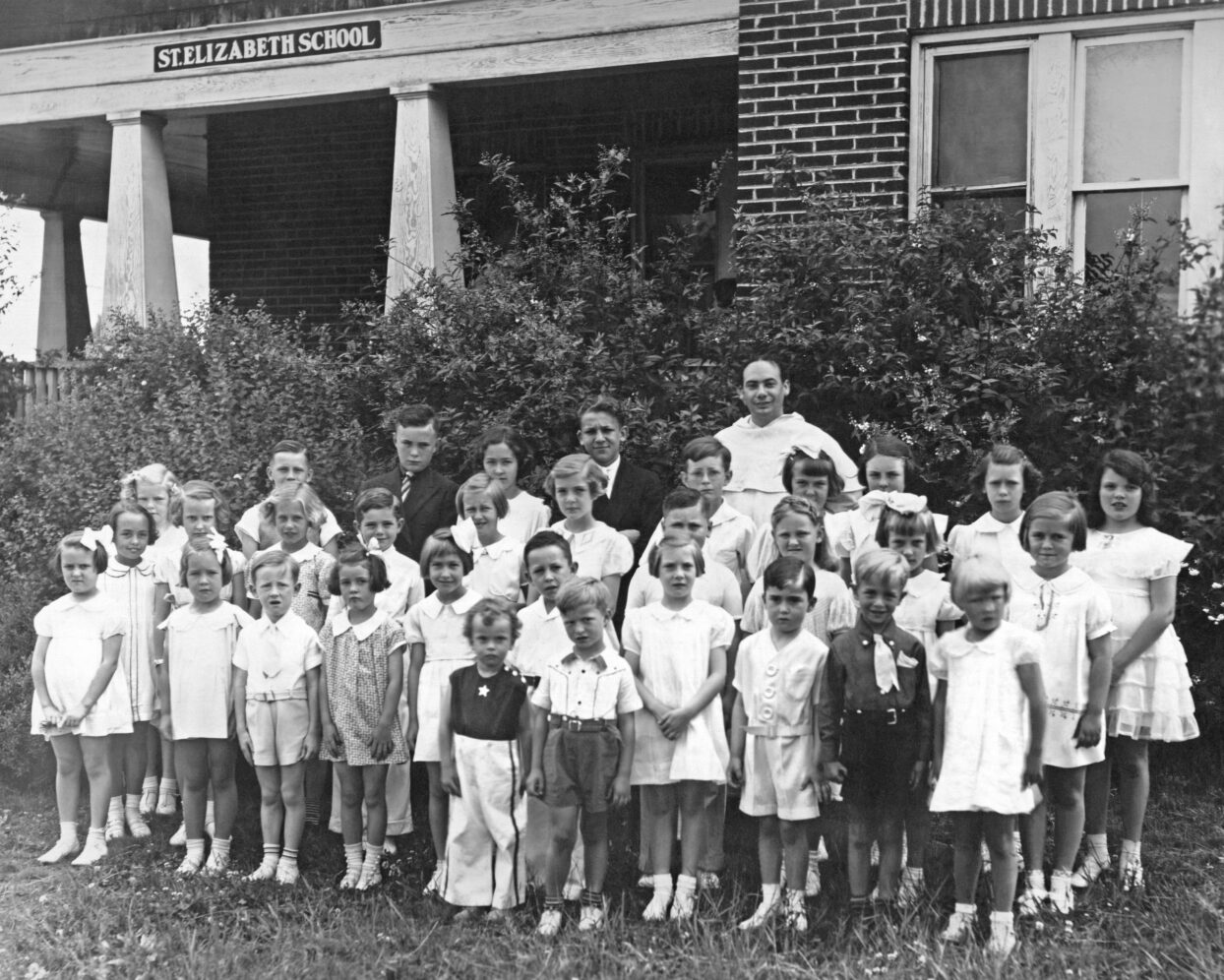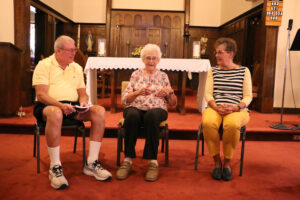St. Elizabeth parishioners unite for a church-wide feast and widespread reminiscing on the centennial
By Bill Brewer
You’ve come a long way, St. Elizabeth. The patroness of Carter County’s only Catholic community surely is smiling as St. Elizabeth Parish in Elizabethton celebrates 100 years of Catholicism in the upper East Tennessee enclave.
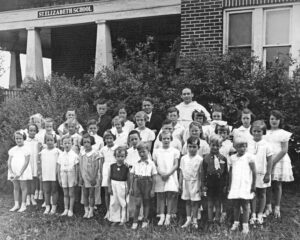
This photo from the early days of St. Elizabeth School was taken by Texas Studio of Elizabethton, courtesy of Betty Jo O’Brien Barker, mother of Richard Barker and Debbie Barker Alexander. Betty Jo estimated that this photo was taken around 1936-37. The priest pictured is believed to be Father J.L. Devine, OP. The photo was taken at the school when it was located at 300 Daytona Place in Elizabethton. The chapel was moved to this two-story house in 1935, and a private Catholic school was opened there. It also served as living quarters for the three Sisters of Mercy from Nashville who staffed the school. The school taught students through ninth grade. In the photo, Betty Jo O’Brien (Barker) is in the back row, second from right, and Lilo Waechter (Duncan) is in the row in front of her, also second from the right (with a bow in her hair).
St. Elizabeth parishioners joined together on Sept. 10 to mark the occasion with a church-wide feast and widespread reminiscing about the decades gone by since a priest on horseback rode the roughly 10 miles from Johnson City to launch a Catholic community in Carter County.
Chief among those remembering the parish’s early days was Lilo Duncan, who continues to be an active member of St. Elizabeth at age 93 and serves as de facto parish historian.
Mrs. Duncan was born in 1930 and as a child attended St. Elizabeth Church and its elementary school, which was established by the Sisters of Mercy.
St. Elizabeth Parish began in 1916 as a mission station of St. Mary Parish in Johnson City. The first Catholic Mass in Carter County is believed to have been celebrated by Dominican Father Q. Beckley on Sept. 9, 1923, at the home of Mr. and Mrs. John Tierney.
Until 1935, when St. Elizabeth Church and School were established on Daytona Place in Elizabethton, Mass was celebrated in parishioners’ homes and at a hotel in downtown Elizabethton. The parish was staffed by Dominican priests from nearby St. Mary.
Father Leo Baldinger became the parish’s first diocesan priest and pastor when St. Elizabeth became a parish in 1945 as part of the Diocese of Nashville, which was founded in 1837. The parish’s current church on West C Street was constructed in 1948-49 during Father Baldinger’s leadership. Father Baldinger left St. Elizabeth in 1952 and was succeeded by Father Albert Siener.
St. Elizabeth School existed for nearly 20 years, was staffed by the Sisters of Mercy, and provided education for grades one through eight. Classes first met in the house at 410 Daytona Place before they moved to a gray stone house at 400 W. G. St. in 1938. The school was moved to the basement of the present church after its May 1949 dedication. Because of a decline in enrollment, St. Elizabeth School closed in 1954, and students began attending St. Mary School in Johnson City.
Also in 1954, Father Siener was reassigned, and St. Elizabeth lost its status as an independent parish, again becoming a mission of St. Mary, with Dominican priests commuting to and from St. Elizabeth.
St. Elizabeth regained its parish status in 1982, and in 1985, with the appointment of Father Charles Johnston, OP, parishioners built a rectory next to the church.
As Mrs. Duncan and longtime fellow St. Elizabeth members Richard Barker and his sister, Debbie Alexander, recalled the history of Catholicism in Carter County, Mrs. Duncan remembered a Father Carter as the first priest to serve St. Elizabeth at the then-converted house with a school.
“The first Catholic Mass was celebrated in Elizabethton 100 years ago on Sept. 9, 1923. It was celebrated at the home of John Tierney on North Main Street in the old part of town in an area called Cat Island. That area got its name because in 1901 we had a significant flood on both the Doe and Watauga rivers, and everybody had to evacuate that area except the cats. The cats climbed the trees and survived the flood,” Mr. Barker recalled.
“Our grandfather, Edward J. “Joe” O’Brien, came to Elizabethton earlier in 1923, we think in the late winter, and he was one of the few people who attended that first Mass here in Elizabethton,” he added.
Mr. Barker’s recollections provided a glimpse of the way many people settled in Elizabethton in the earliest years of the 20th century.
“He (Joe O’Brien) was born in Rome, Ga., and then they moved to Aniston, Ala., when he was young, and then he grew up in Birmingham (Ala.). His father had a small construction company. His father died around 1920, and our grandfather and an uncle of his named Pat O’Brien brought that small construction company here on the railroad in order to grade what is now State Line Road here on the eastern end of Elizabethton. They did grading work.
“Another parishioner who was here at that time, his name was John McCready, and he was a civil engineer. He was a graduate of the University of Richmond. He said our grandfather had the biggest mules he had ever seen. All that work was basically done with livestock because they didn’t have much construction equipment in 1923,” Mr. Barker said. “The first person he (Joe O’Brien) met was Roy Hathaway, who owned a funeral home. The funeral home is still here. And they were friends the rest of their lives. The business now is called Hathaway-Percy Funeral Home.”
Mr. Barker and Mrs. Alexander explained how there were few Catholics in the Elizabethton area in the first years of the 20th century, and the few Catholics who were there were determined to establish a Catholic church in Elizabethton.
“When they (the small Catholic community) would have dinners to help raise money to help build the church, Mr. Hathaway would sneak in the back door and slip a $100 bill in one of the parishioner’s pockets to help with the fundraising,” Mr. Barker said, referring to the funeral home owner.
“He never wanted anybody to know what he did. He was very generous, but he was a very private man,” Mrs. Alexander added about Mr. Hathaway.
Mr. Barker, who is 70, and Mrs. Alexander, who is 68, join Mrs. Duncan in genuine appreciation for how Catholicism has progressed in an area where Protestants have always outnumbered Catholics by a wide margin.
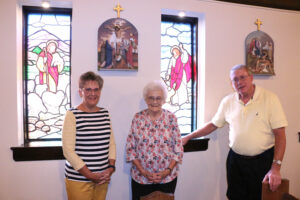
Debbie Alexander (left), Lilo Duncan, and Richard Barker stand in front of two stained-glass windows and two Stations of the Cross at St. Elizabeth Church. The Stations at the church were purchased earlier this year. The stained-glass windows were installed in 1998 and dedicated during a 50th-anniversary celebration of the church’s construction. Windows on the east side of the church depict scenes from the Old Testament while those on the west are from the New Testament. Groundbreaking for the church was Sept. 7, 1948, with the dedication on May 15, 1949, although the first Mass in the building was on April 14, 1949.
Mrs. Duncan easily vocalizes the street addresses of the former locations where Masses were first held in Elizabethton and the names of early Catholics who would join together once or twice a week for Mass in a home until a church could get established.
And she fondly remembers the Sisters of Mercy who were St. Elizabeth School’s first teachers. While nuns have a reputation, warranted or not, for being stern school disciplinarians, Mrs. Duncan remembers them in a much different way.
They had such a positively profound impact on her and the other early students that many years later Mrs. Duncan traveled to Knoxville to visit former teacher Sister Mary de Lellis Allison, RSM, who was no longer teaching. Sister Mary de Lellis was at St. Mary Medical Center when the visit took place.
“She was our Loretta Young. We had three nuns who taught at the school. I had nuns in grades one through eight. I never had any other teacher but nuns. They were wonderful people. We had the sweetest nuns, we really did. They were as sweet to us as they could be,” Mrs. Duncan remembered.
Following elementary school, Mrs. Duncan attended Elizabethton High School, which is a public school. She said there were about 80 students at St. Elizabeth when she attended, and a number of them were not of the Catholic faith, which is remarkable since Catholics were not only decidedly in the minority but often were not well thought of by some members of the community.
Mrs. Duncan said in those early days 100 years ago Catholics weren’t very welcome in Elizabethton.
“They always kind of shunned the Catholics. The nuns would go to town to buy things, and they were called ‘haints,’ meaning ghosts. It was just ignorance. But as time went on, things got better. More people were coming in. The Catholic community was involved in the broader Elizabethton community. We had the school,” explained Mrs. Duncan, who graduated from East Tennessee State University with a degree in education.
She said after graduation from ETSU, she was hired in 1952 to teach at an area school and, unbeknownst to her, a Protestant preacher passed around a petition to keep her from teaching.
“Now, this is how God works. This preacher’s daughter later married a Catholic, and I was the godmother of every one of his grandchildren. Isn’t that funny how God works?” Mrs. Duncan asked.
Mrs. Alexander noted that the preacher’s daughter married a young man who was a member of St. Elizabeth.
Mr. Barker and Mrs. Alexander recall that as school-age children some people in the community wouldn’t associate with them because they were Catholic.
“It’s completely different now. Thank goodness,” Mrs. Alexander said.
Mrs. Duncan, Mrs. Alexander, and Mr. Barker share memories of popular bingo events the church hosted in the past that attracted scores of Carter County residents.
“That’s how we made a lot of our money to do things for this church,” Mrs. Alexander said.
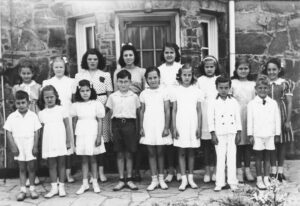
This photo, courtesy of Betty Jo Barker, was probably taken circa 1938-39 after the St. Elizabeth chapel and school were moved in 1938 from the Daytona Place house to a larger graystone house at 116 E. G St., at the corner of East G Street and Watauga Avenue. Lilo Waechter (Duncan) is in the back row, third from the right.
How Catholics came to be members of a small town in the heart of the Bible belt is part of the rich history of Catholicism in Carter County.
Mr. Barker said Elizabethton was rural and isolated until industry gave the town an economic and population jumpstart. He noted that until industry moved into Elizabethton in 1926, the only practical way to enter and exit the town was by rail since a good road system was yet to be built.
“Until the first rayon plant opened here, Elizabethton was pretty isolated. Really, the best way to get in and out of here was by railroad. I remember my grandfather talking. He said on Sunday he would go to Johnson City to church at St. Mary before there was a church established here. He said it took about two hours to get to St. Mary, and you always had a flat tire along the way. The roads were not good until the plants came into existence in 1926,” Mr. Barker said.
Mrs. Alexander recalled that the first plants were American Bemberg Corp. and North American Rayon, both of which made rayon fabric. The siblings’ father and grandfather worked at one of the plants.
Bemberg was formed in Germany, and its U.S. subsidiary made both high-quality rayon fabric for the clothing industry and parachutes for the U.S. military in World War II and the Korean War. And Germans who were Catholic emigrated to Elizabethton to work at the plant. Germans who were of the Lutheran faith also moved into the Elizabethton area and established two Lutheran churches.
“My parents were German and came here from Germany. My dad was Lutheran but later on became Catholic,” Mrs. Duncan pointed out.
Mrs. Duncan said that during World War II more than 4,000 workers were employed by the two plants. According to Mr. Barker, the Bemberg plant closed around 1975-76, and the North American Rayon plant closed in 1997.
But other industry has filled the need for jobs and economic stability, with Snap-on Tools operating a manufacturing plant in Elizabethton that first opened in 1974, A.Y. McDonald producing plumbing, water works, pumps, and natural gas products at a plant that opened in 1999, and Mapes Strings producing strings for musical instruments and wire for industrial uses. It opened a manufacturing plant in Elizabethton in 1950 and has grown to be a major supplier to the music business.
The Carter County seat also is home to three locally owned banks, and the Elizabethton Star newspaper publishes twice a week.
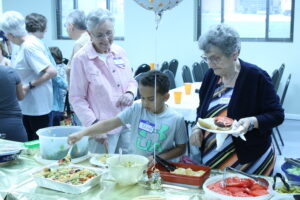
Tina Wachs (left), Elijah Bienaime, and Agnes Policky take part in the meal for St. Elizabeth parishioners Sept. 10 as they celebrated the 100th anniversary of Catholicism in the area. The parish provided hamburgers and hot dogs, fixings, and drinks for the meal. The Knights of Columbus grilled the burgers and hot dogs. Parishioners also brought dishes to the feast.
“I think the only businesses that are still open and running today that were open in 1923 are Burgie Drug Store, Hathaway-Percy Funeral Home, and the Elizabethton Star newspaper,” Mr. Barker said, noting that the population of Elizabethton now is right at 14,000 and the population of Carter County is 55,000-56,000.
St. Elizabeth Parish is home to 150-160 families, with Sunday Mass attendance averaging about 150 people, according to Mr. Barker.
“When Richard and I were young, we had maybe 50 in church for Mass,” Mrs. Alexander said.
Mass attendance continually grew, and in 1986 a weekly Saturday vigil Mass was added. When that Mass first began, about 10 people attended. Nearly 100 attended a vigil Mass in September.
Mrs. Duncan has noticed the appreciable growth in Mass attendance.
“We don’t know if they’re coming from Johnson City over to here. Now everybody who owns a business tells me so many people are moving in here from other states. And I believe that,” she said.
Mr. Barker pointed out that during the pandemic, five families moved into the parish from upstate New York.
“We have had a number of people move here from New York and up north. We were talking about church, and I said where you all are from you have a lot of Catholic churches to go to. I said here, we have one. I said there is a Baptist church on every corner here. And they said where we’re from there’s a Catholic church on every corner. We have never experienced that,” Mr. Barker said.
“We’ve never had that opportunity. There have been very few Catholics here,” Mrs. Duncan added. “There are five Protestant churches on my way home from church, so that tells you something. … Even when we built this church the Catholic population here was small.”
While growth has been good for the city, county, and parish, Mrs. Duncan believes there is a happy medium. When asked about the growth of the Tri-Cities area in recent decades and the prospect for future growth, she said laughing, “It’s big enough. We don’t want it any bigger,” to which Mrs. Alexander added, “Sometimes less is more.”
As the Elizabethton area expands, it’s clear the Catholic community in Carter County is now an integral part of the broader community.
St. Elizabeth is a key contributor to Assistance and Resources Ministries, a multi-denominational nonprofit organization in Carter County that provides food, clothing, household items, and other assistance to residents in the area. It was formed in 1991.
And St. Elizabeth Knights of Columbus Council 10743 provides assistance to the parish and also to Carter County organizations.
Mr. Barker noted that Council 10743 recently raised nearly $2,000 and donated it to the Carter County School District for a special-education program at Hampton High School. He pointed out that Council 10743, in conjunction with the Tennessee Knights of Columbus, provides grants to the Carter County school system for needs the school system is trying to meet and to other Tri-Cities organizations as well.
“We’ve actually donated more to the local schools here than we’ve collected because we’ve relied on state funds that other councils did not use. We have an active Knights of Columbus council here that has done great work. We’ve been doing it for 32 years,” he said.
Mrs. Duncan, Mrs. Alexander, and Mr. Barker spoke highly of Father Dennis Kress, who served as St. Elizabeth’s pastor for two decades, from July 1, 2003, to July 1, 2023. Father Kress also served as parochial administrator of St. Anthony of Padua Parish in Mountain City during that period.
The three St. Elizabeth members complimented Father Kress for his stewardship of church finances, his homilies, how he assimilated so well into the St. Elizabeth community, and how well he related to parishioners.
Father Jesús Guerrero in July succeeded Father Kress at St. Elizabeth and St. Anthony of Padua.
Father Guerrero still is getting to know his new parish and its members, and they still are getting to know him.

Father Jesús Guerrero and Deacon Richard Carner stand outside St. Elizabeth Church. “I really like St. Elizabeth. I really do. I really like the people,” Deacon Carner said. “It’s a small community, and you get a chance to know people, and to laugh with people, and to listen to them.”
Even so, St. Elizabeth already is having an impact on the priest.
“I am new to the parish, only two months here,” he said in September. “I had been at St. Mary for eight years, but I did not know much about St. Elizabeth, which is only 15 minutes away from St. Mary.”
“The church is beautiful inside. It’s a very traditional-looking church. The community is very welcoming. It’s been a blessing to me to be assigned to this church,” Father Guerrero added.
Like Father Guerrero, Deacon Richard Carner served at St. Mary in Johnson City. He was assigned to St. Elizabeth eight years ago.
And also like Father Guerrero, Deacon Carner is impressed by the century-old Catholic community in Carter County as they lead St. Elizabeth into its next century.
“I really like St. Elizabeth. I really do. I really like the people. It’s a small community, and you get a chance to know people, and to laugh with people, and to listen to them,” Deacon Carner said. “The parish is made up of the people, and the people here are really great.”
The city of Elizabethton would agree. How to tell?
In 1998 and 1999, St. Elizabeth parishioners celebrated the 75th anniversary of Catholicism in Carter County and the 50th anniversary of the church building. During a Homecoming Mass on Sept. 20, 1998, to commemorate the 75th anniversary, then-Bishop Anthony J. O’Connell blessed 24 new stained-glass windows that continue to adorn the church.
After the Mass, the Elizabethton mayor at the time, Richard Sharpin, presented Bishop O’Connell with a certificate naming him an honorary mayor of the city.
Mayor Sharpin was a St. Elizabeth parishioner.

